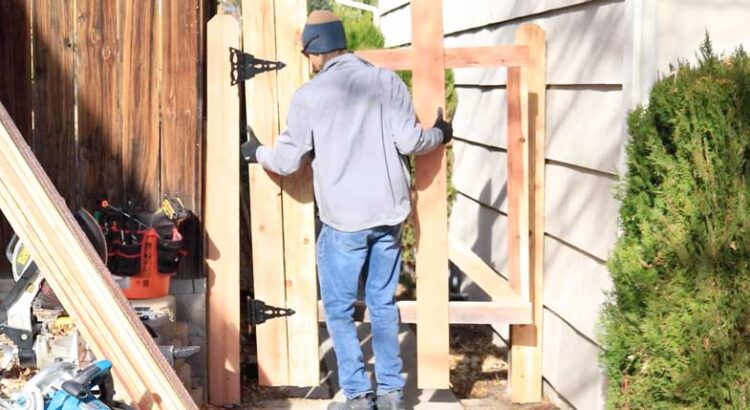A fence gate is an essential feature for any property, providing access while maintaining security and privacy. Installing a fence gate can seem like a challenging task, but with the right tools, materials, and instructions, it’s an entirely manageable project for most homeowners. Whether you’re looking to enhance your curb appeal or create a functional entrance, a well-installed fence gate can significantly improve both the aesthetic and security of your home. Below, we will outline the key steps for installing a fence gate with precision and ease.
1. Planning and Preparation
Before starting the installation process, it’s crucial to carefully plan your project. Begin by deciding the location and design of the gate, taking into consideration the size of your fence, the level of privacy you require, and the overall style of your home. There are several types of fence gates to choose from, including swinging, sliding, or bi-fold designs, so understanding the best option for your space is essential.
- Measure the Space: Use a tape measure to determine the width of the gap where the gate will be installed. Typically, a gate should be 1-2 inches narrower than the fence opening to allow for clearance and proper swinging.
- Select the Gate Type: Based on your needs and space, choose a swinging gate, which opens inwards or outwards, or a sliding gate if your space is limited. Each type requires different hardware, so selecting the correct style will determine the tools and materials you need.
- Check for Obstructions: Ensure that the area around the gate is clear of any obstacles, such as bushes or trees, that could obstruct the gate’s movement once installed.
2. Gather Necessary Tools and Materials
The tools you need will depend on the type of gate you are installing. However, most fence gates require the following basic materials and tools:
- Gate: Purchased or built to fit your desired measurements.
- Gate Hinges: Heavy-duty, adjustable hinges are essential for supporting the weight of the gate.
- Gate Latch or Lock: For added security, a reliable latch or locking mechanism is necessary.
- Post: A sturdy post to support the gate.
- Concrete: For setting the post in the ground and ensuring stability.
- Screws and Nails: To attach hinges and other hardware.
- Tools: A level, drill, screwdriver, post hole digger, hammer, wrench, measuring tape, and a saw (if custom adjustments are needed).
3. Setting the Gate Post
The first step in installing your fence gate is setting the gate post. The gate post must be strong enough to support the weight of the gate and withstand the force of use over time.
- Dig the Post Hole: Using a post hole digger, dig a hole where the gate post will be placed. The hole should be about 24-36 inches deep to ensure the post is secure.
- Set the Post in Concrete: Place the post in the hole and use a level to make sure it is plumb (perfectly vertical). Once the post is correctly aligned, pour concrete around it to hold it in place. Allow the concrete to cure for at least 24-48 hours to ensure a firm, stable base.
- Ensure Proper Alignment: Double-check the post’s positioning to ensure that it aligns with the rest of the fence and is set to the correct height. The top of the post should be level with the top of the surrounding fence posts.
4. Attaching the Hinges
Once the post is set, it’s time to attach the hinges to the gate. The hinges must be positioned correctly to ensure that the gate swings smoothly and doesn’t sag.
- Position the Hinges: Place the hinges on the side of the gate that will face the post. For most gates, two or three hinges will suffice, depending on the gate’s size and weight. The hinges should be placed about 6-8 inches from the top and bottom of the gate to evenly distribute the weight.
- Attach the Hinges to the Gate: Use a drill and screws to secure the hinges to the gate. Be sure to drill pilot holes before inserting screws to prevent the wood from splitting or the screws from loosening over time.
- Align the Hinges on the Post: Position the hinge plates on the post, ensuring that the gate is hanging properly. The gate should be level and aligned with the surrounding fence. If adjustments are needed, loosen the hinge screws, reposition, and retighten until the gate swings freely without dragging or sagging.
5. Installing the Latch and Locking Mechanism
Once the gate is hung and swinging smoothly, it’s time to install the latch or locking mechanism. The latch should be placed at a comfortable height for accessibility and securely attached to both the gate and the post.
- Position the Latch: Place the latch on the side of the gate that faces inward or toward the driveway, depending on your preference. For added security, consider using a combination lock or deadbolt, especially if the gate is a primary entry point to your property.
- Attach the Latch to the Gate and Post: Secure the latch mechanism to both the gate and the post, ensuring that it locks and unlocks easily. Make sure the latch lines up perfectly to avoid any difficulty opening or closing the gate.
6. Adjusting the Gate for Smooth Operation
At this stage, the gate should be fully functional. However, to ensure that it operates smoothly, some fine-tuning may be necessary.
- Check for Level: Use a level to ensure that the gate is hanging evenly and not tilted. If necessary, adjust the position of the hinges or tighten the screws to prevent sagging.
- Test the Swing: Open and close the gate several times to check for smooth operation. The gate should swing freely without dragging on the ground or scraping the post.
- Adjust for Clearance: Ensure there is enough clearance between the bottom of the gate and the ground to prevent it from catching on debris or becoming difficult to open over time.
7. Final Touches and Maintenance
Once the gate is properly installed and functioning, consider adding finishing touches to ensure both appearance and longevity.
- Paint or Stain: To protect the gate from the elements, apply a weather-resistant paint or stain. This will help maintain the gate’s appearance and prevent premature wear and tear.
- Regular Maintenance: Periodically check the hinges, latch, and post to ensure they remain secure. If you notice any loose screws or rusted hardware, replace them promptly to maintain the gate’s function and appearance.
Conclusion
Installing a fence gate may seem like a daunting task, but with careful planning and attention to detail, it can be a rewarding DIY project that improves the functionality and aesthetic of your property. By following these steps—planning, setting the post, attaching the hinges, installing the latch, and ensuring proper operation—you can create a secure, stylish entrance for your home. With a little maintenance, your new gate will serve you for many years to come, providing both security and curb appeal.





